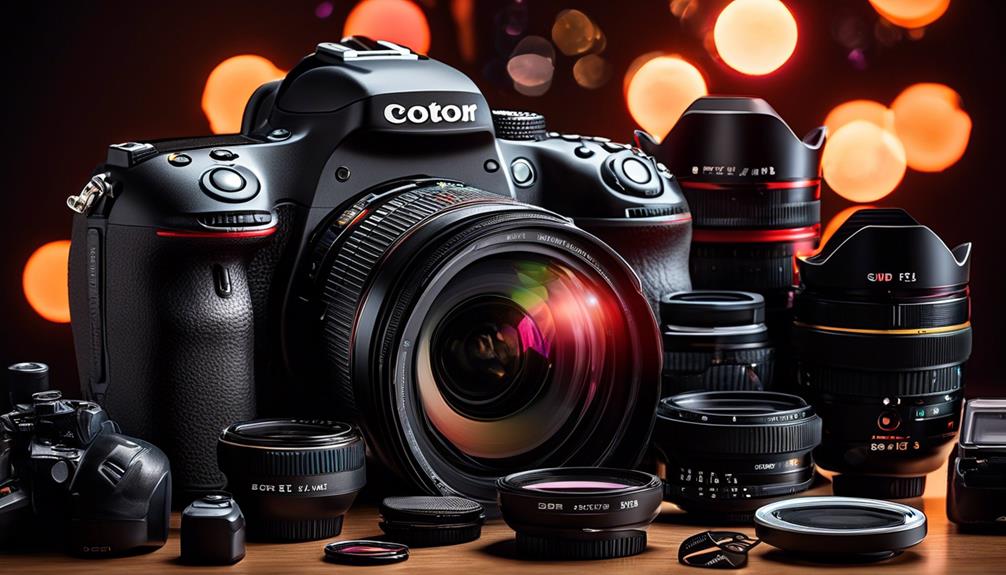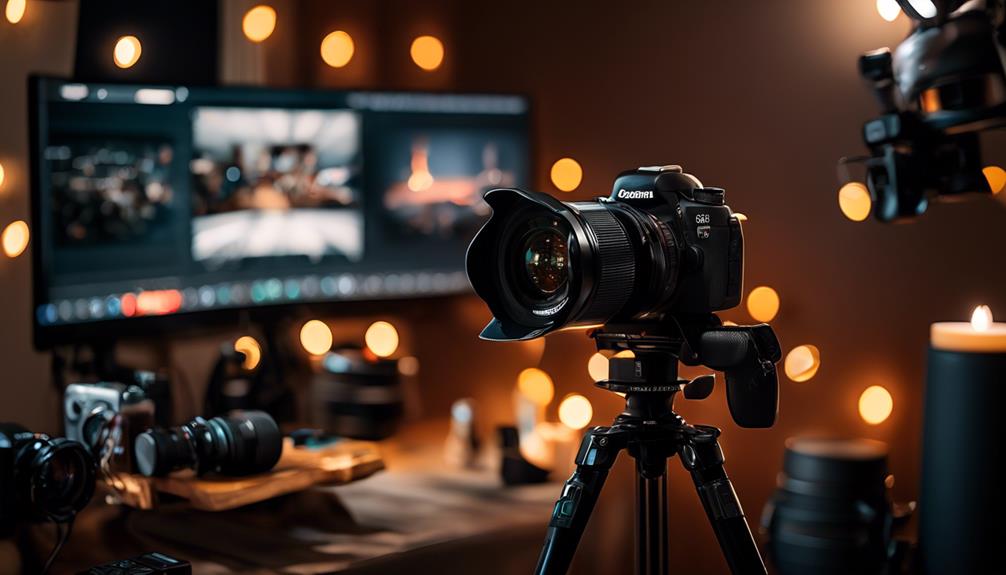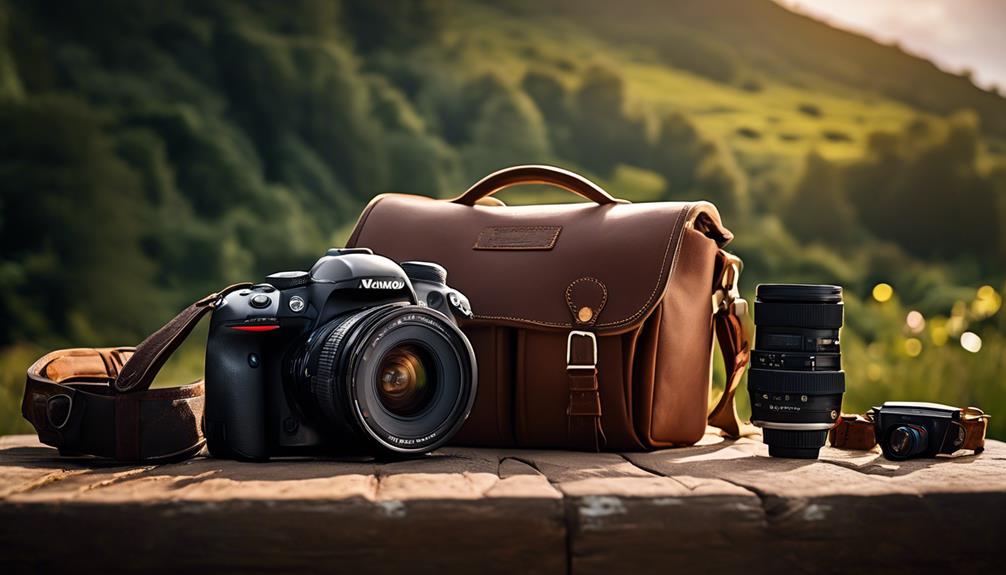Please note this post may contain affiliate links picked by me (Jay) that I have deemed may be of interest or relevant to you the reader of this.
These links do not affect the cost of the thing if you decide to purchase but i may get a little money if you choose to purchase.
For more information on my affiliate link policy click here.
As a beginner photographer, you may be wondering if investing in gadgets is really necessary to enhance your photography skills.
Well, let me assure you that having the right tools can make a world of difference in capturing stunning images.
From the essential camera body and lens essentials to tripod stabilizers and external flash, there are nine gadgets that every aspiring photographer should consider.
These gadgets will not only help you achieve better image quality but also expand your creative possibilities.
So, if you're ready to take your photography to the next level, let's explore the top nine essential gadgets that will elevate your skills and bring your vision to life.
Key Takeaways
- The camera body is crucial for capturing great images, and investing in a high-quality one allows room for growth and skill development.
- Lens selection depends on the type of photography pursued, with versatile zoom lenses and wide aperture prime lenses being essential for different subjects.
- Tripods and stabilizers are essential for achieving sharp, professional-looking images, enabling experimentation with composition techniques and various shooting styles.
- External flash can provide improved lighting control and creative setups, reducing red-eye in portraits and being a versatile tool for different photography genres and lighting conditions.
Camera Body
As a beginner photographer, I find that selecting the right camera body is a crucial decision that sets the foundation for capturing incredible images. The camera body serves as the main component of your photography gear, and choosing the right one can greatly enhance your shooting experience. When it comes to camera accessories, the body is where it all begins.
Camera bodies come in a variety of options, each with its own unique features and capabilities. From entry-level models to professional-grade options, there's a camera body to suit every photographer's needs. When making your selection, it's important to consider factors such as image quality, sensor size, autofocus system, and overall performance. These features will greatly impact the quality of your images and the level of control you have over your camera settings.
Investing in a high-quality camera body won't only allow you to capture stunning photos but also provide you with room to grow and expand your skills as a photographer. With innovative advancements in camera technology, there are always new and exciting features being introduced. So, whether you're just starting out or looking to upgrade, selecting the right camera body will set you on the path to capturing breathtaking images.
Lens Essentials
Now that we've selected the perfect camera body, let's dive into the world of lens essentials for beginner photographers.
The lens you choose can make a huge difference in the quality of your photographs, so it's important to select the right one for your needs. Here are some lens essentials to consider:
- Lens selection: When choosing a lens, think about the type of photography you want to pursue. A versatile zoom lens, like a 24-70mm or 18-55mm, is great for capturing a wide range of subjects. Alternatively, if you're more interested in portrait photography, a prime lens with a wide aperture, like a 50mm f/1.8, will give you beautiful bokeh and sharp focus.
- Lens care and maintenance: Taking care of your lenses is essential for keeping them in top condition. Invest in a lens cleaning kit, which typically includes a lens cloth, cleaning solution, and a blower brush. Regularly clean your lenses to remove dust and fingerprints. Additionally, always store your lenses in a protective case or bag to prevent any damage.
Tripod and Stabilizers
Using a tripod or stabilizer can greatly enhance the quality and stability of your photographs, allowing you to capture sharp, professional-looking images. Whether you're a beginner or an experienced photographer, these tools are essential for achieving stunning results.
When it comes to smartphone photography, a tripod or stabilizer is even more crucial. Smartphones are lightweight and can easily shake when taking photos, leading to blurry images. By using a tripod or stabilizer, you can eliminate this problem and ensure that your photos turn out clear and crisp.
Furthermore, tripods and stabilizers aren't just for holding your camera steady. They also provide you with the flexibility to experiment with different photography composition techniques. With a tripod, you can easily achieve long exposure shots, capture motion blur, or even create stunning time-lapse videos.
Additionally, these gadgets allow you to take self-portraits or group photos without relying on others. You can set up your smartphone on a tripod, adjust the angle, and use a timer or remote control to capture the perfect shot. This opens up a whole new world of possibilities for capturing memorable moments.
External Flash
One essential gadget that can greatly enhance your photography is an external flash. Here are four reasons why you should consider adding this tool to your camera bag:
- Off Camera Lighting:
With an external flash, you have the flexibility to position the light source away from your camera. This allows you to create more dynamic and creative lighting setups, resulting in professional-looking images.
- Improved Lighting Control:
External flashes provide more power and control over the lighting situation compared to the built-in flash on your camera. You can adjust the intensity of the flash, change the direction of the light, and even use modifiers like diffusers to soften the light and create a more flattering effect.
- Reduced Red-Eye:
The built-in flash on cameras often causes red-eye in portraits. By using an external flash positioned away from the camera, you can greatly reduce the occurrence of this unwanted effect, resulting in more natural-looking portraits.
- Versatility:
External flashes can be used in a variety of photography genres, including portraits, events, and even outdoor photography. They're a versatile tool that can adapt to different lighting conditions and help you capture stunning images in any situation.
Memory Cards and Storage
To ensure ample storage for capturing high-quality photographs, investing in reliable memory cards and storage devices is essential for every beginner photographer. When it comes to memory card types, there are a few options to consider.
The most common ones are SD (Secure Digital) cards, which come in different sizes and speeds. They're widely supported by cameras and offer a good balance between storage capacity and price. For those who need faster write speeds and larger storage capacities, SDXC (Secure Digital Extended Capacity) cards are a great choice. They can handle high-resolution images and videos without any issues.
Another popular option is microSD cards, which are smaller in size and often used in smartphones and action cameras.
In addition to physical memory cards, it's also worth exploring cloud storage options. Cloud storage allows you to store your photos online and access them from anywhere with an internet connection. This is particularly useful for backing up your images and ensuring their safety in case of loss or damage to your physical storage devices.
There are many cloud storage providers available, each offering different storage plans and features. Some popular options include Google Drive, Dropbox, and iCloud.
Camera Bag and Accessories
A camera bag is an essential accessory for every photographer, providing a convenient and protective way to carry and organize their valuable gear. As a beginner photographer, you'll want to invest in a camera bag that not only offers ample space for your camera body and lenses but also has compartments for accessories and a padded interior to protect your equipment from bumps and scratches.
Here are some camera bag accessories that can enhance your photography experience:
- Stylish Camera Straps: Upgrade from the standard camera strap that comes with your camera. Stylish camera straps not only add a touch of personality to your gear but also provide comfort and support during long shooting sessions.
- Lens Cleaning Kits: Keep your lenses clean and free from smudges with a lens cleaning kit. These kits typically include a microfiber cloth, lens cleaning solution, and brush, ensuring your lenses are always ready to capture sharp and clear images.
- Memory Card Wallet: Stay organized and protect your valuable memory cards with a memory card wallet. These compact and lightweight wallets keep your cards safe from dust, moisture, and damage.
- Tripod Mounts: For stable and shake-free shots, invest in a tripod mount. This accessory allows you to attach your camera to a tripod, providing stability and flexibility in various shooting situations.
Remote Shutter Release
With a remote shutter release, photographers can capture images with precision and minimal camera shake, allowing for greater creative control and stunning results. A remote shutter release is a must-have gadget for any beginner photographer looking to take their skills to the next level.
This wireless option eliminates the need to physically press the shutter button on the camera, reducing the risk of camera shake that can blur images. By using a remote shutter release, you can take long exposure shots without the need to touch the camera, ensuring sharp and clear images even in low-light conditions.
The remote shutter release also offers other advantages, such as the ability to capture self-portraits or group shots without having to rely on timers or asking someone else to take the photo. It gives you the freedom to experiment and explore your creativity without being restricted by the limitations of holding the camera.
Whether you're capturing a breathtaking landscape or a fast-paced action shot, a remote shutter release allows you to capture the moment with precision and control.
Filters and Lens Attachments
One of the essential gadgets that can enhance the capabilities of beginner photographers is the use of filters and lens attachments. These accessories not only allow you to experiment with different effects and styles but also enable you to push the boundaries of your creativity.
Here are four reasons why filters and lens attachments are a must-have for any aspiring photographer:
- Macro photography: With the use of macro filters or extension tubes, you can capture stunning close-up shots of subjects, revealing intricate details that are often missed by the naked eye. This is perfect for capturing the beauty of flowers, insects, and other small objects.
- Long exposure techniques: Filters such as neutral density (ND) filters can help you achieve long exposure effects, such as silky smooth waterfalls or dreamy cloud movements. By reducing the amount of light entering your camera, these filters allow you to extend your exposure time and create mesmerizing images.
- Polarizing filters: These filters are great for landscape photography as they reduce glare and reflections, enhancing color saturation and contrast. They also help to darken skies, making clouds pop and creating a more dramatic effect.
- Creative effects: Lens attachments like fisheye, wide-angle, and telephoto lenses offer unique perspectives and allow you to capture a wider field of view or zoom in on distant subjects. These attachments open up a world of creative possibilities, enabling you to capture stunning images that stand out from the crowd.
Editing Software
After exploring the world of filters and lens attachments, it's time to take our photography skills to the next level with the power of editing software. Post-processing techniques are essential in enhancing and refining our photographs, allowing us to create stunning images that truly stand out. With the advancements in technology, there are now numerous editing software options available that provide us with advanced editing tools to bring our vision to life.
One such software is Adobe Lightroom, which offers a range of powerful features for organizing, editing, and sharing our photos. Its intuitive interface and comprehensive tools make it a favorite among photographers of all levels. With Lightroom, we can adjust exposure, color balance, and sharpness, as well as apply creative effects and filters to transform our images.
Another popular choice is Capture One, known for its exceptional color grading capabilities and precise control over image details.
For those seeking more innovative options, DxO PhotoLab and Luminar AI are worth exploring. DxO PhotoLab utilizes artificial intelligence to automatically enhance our images, while Luminar AI offers an array of intelligent editing tools, including AI Sky Enhancer and AI Skin Enhancer, to take our creativity to new heights.
Frequently Asked Questions
How Do I Clean My Camera Lens Properly?
Cleaning my camera lens properly is essential for maintaining its performance and capturing high-quality photos.
To ensure a thorough clean, I follow a few lens cleaning techniques.
Firstly, I use a blower brush to remove any dust particles.
Then, I gently wipe the lens using a microfiber cloth or lens cleaning solution. It's important to avoid using rough materials or excessive pressure, as this can damage the lens.
Regular camera lens maintenance guarantees optimal image clarity and sharpness.
What Are Some Tips for Shooting in Low Light Conditions?
When shooting in low light conditions, it's important to minimize noise and make the most of artificial lighting techniques.
One tip I've found helpful is to use a wide aperture, allowing more light to enter the camera sensor.
Additionally, utilizing a tripod can help stabilize the camera and reduce blurriness.
Another technique is to increase the ISO, but be cautious as it can also introduce noise.
Lastly, experimenting with different light sources, like LED panels or off-camera flashes, can add creativity and enhance your low light shots.
How Can I Improve My Photography Composition?
Improving photography composition involves understanding the rule of thirds, which helps balance subjects within the frame. By dividing the image into thirds horizontally and vertically, you can place your main subject off-center for a more dynamic composition.
Additionally, incorporating leading lines, such as roads or fences, can guide the viewer's eye through the image and create a sense of depth. These techniques add interest and creativity to your photos, enhancing the overall visual impact.
What Are Some Common Photography Mistakes to Avoid?
I've made my fair share of common photography mistakes in the past, but I've learned from them and improved my skills.
One mistake to avoid is poor composition, as it can make or break a photo.
Another mistake is forgetting to use essential camera accessories, like a tripod or lens filters. These gadgets can greatly enhance the quality of your shots.
How Do I Choose the Right Camera Settings for Different Situations?
Choosing the right camera settings can be a bit overwhelming at first, but it's essential for capturing great photos. When it comes to aperture vs. shutter speed, aperture controls the depth of field while shutter speed determines how motion is captured.
Manual mode gives you full control over these settings, allowing for more creativity. However, if you're just starting out, auto mode can be helpful until you become more comfortable.
Experimenting with different settings is key to finding your own style.
Conclusion
In conclusion, these essential gadgets for beginner photographers are a game-changer for capturing stunning shots.
From the camera body to lens essentials, tripod, and stabilizers, each tool plays a vital role in perfecting your photography skills.
So why wait? Take your photography to the next level with these gadgets and unlock your creative potential.
Are you ready to capture moments that will last a lifetime?


